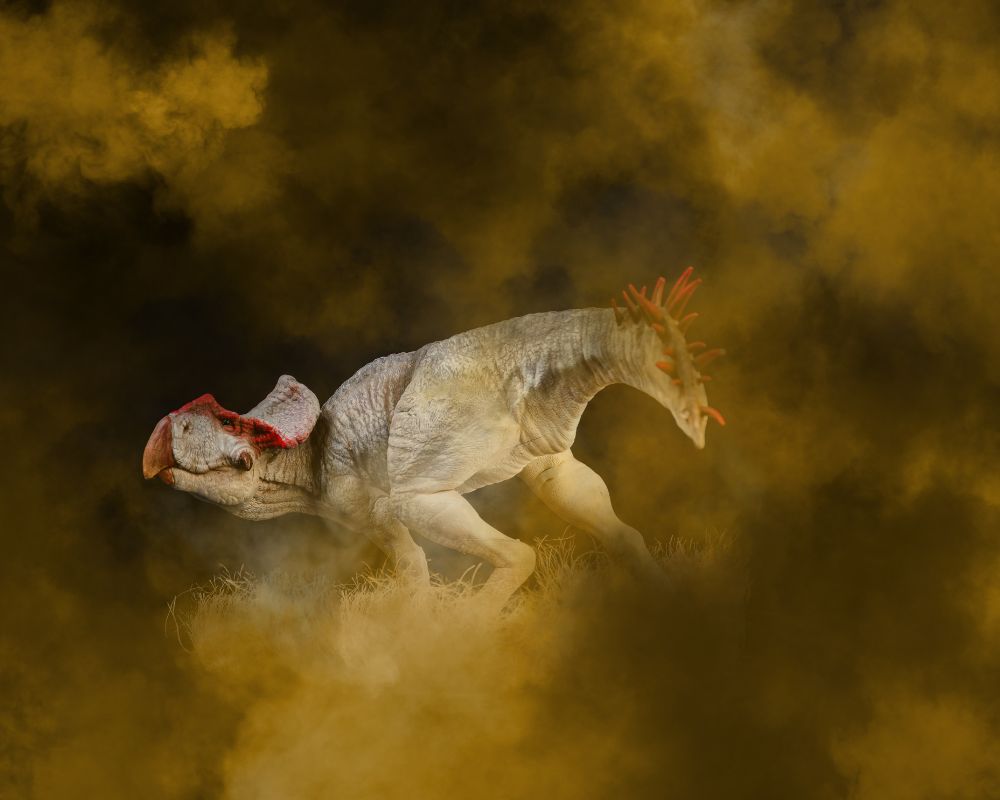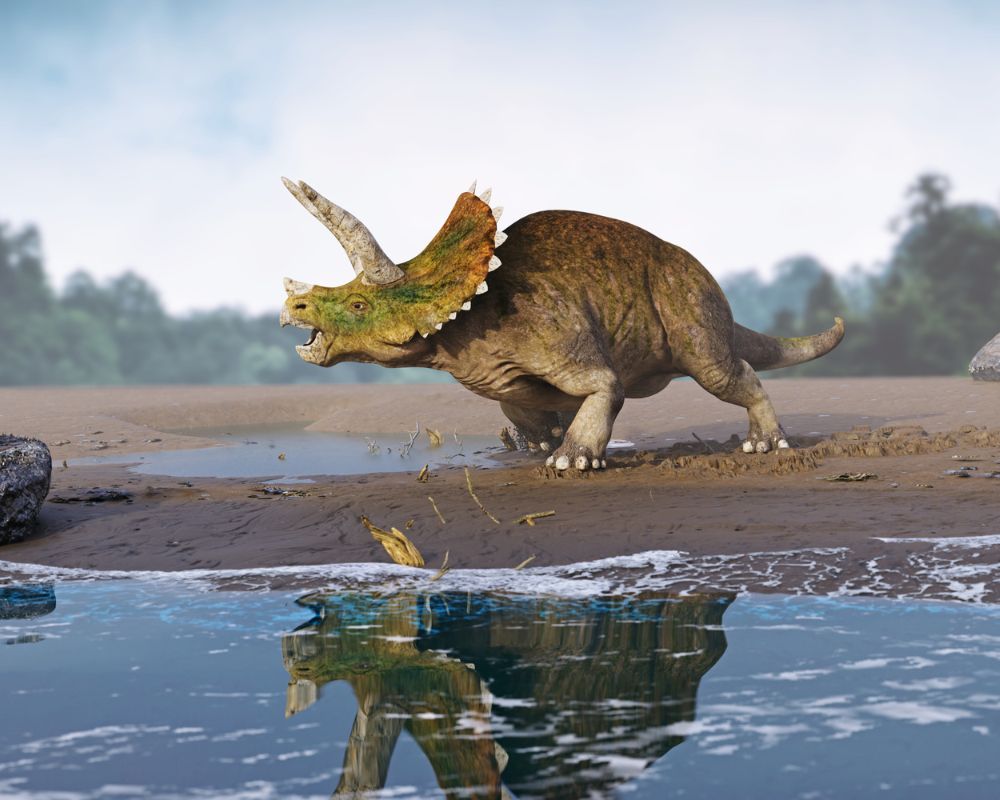Ceratopsians were a pre-historic species of ornithopods known for their flashy neck frill and signature horns. They were some of the most predominant species of dinosaurs of the Cretaceous age and had some pretty neat characteristics that made them stand out in a dino crowd.
Table of Contents
Some Quick Facts About the Ceratopsians

| Name | Ceratopsians (horned face) |
| Type of dinosaur | Ornithischia |
| Territory | Grasslands, Asia, Europe, North America |
| Size | 3-30 feet |
| Color | Bumpy, scaly skin, brown |
| Interesting Characteristics | Large nasal horn, neck frill |
| Diet | Plants |
| Major Threats | Larger theropods, like the Tyrannosaurus Rex |
Ceratopsians were unique Cretaceous dinosaurs living in North America, Asia, and Europe.
The most famous dinosaur in this family is the Triceratops, with its three horns and large neck fill. While the sizes of these dinosaurs varied by species, the largest Ceratopsian grew to over 30 feet long and weighed over 12,000 pounds!
What dinosaurs were Ceratopsians?
The classification of Ceratopsians falls under three divisions:
- Psittacosauridae
- Protoceratopsidae
- Ceratopsidae
Let’s dive into the different types of Ceratopsians, starting from the earliest.
1. Psittacosauridae

These dinos were the first of the Ceratopsians. They were small, bipedal, and had small neck frills and no horns.
They were an early version of Ceratopsians but were much smaller without the signature flair (like neck frills and horns). Examples of the Psittacosauridae include:
- Psittacosaurus
- Chaoyangsaurus
2. Protoceratopsidae

The Protoceratopsidae were the very first Ceratopsians to walk on all four legs.
They were larger than Psittacosauridae and roamed the earth during the early Cretaceous period. While they had a large neck frill, this type of dinosaur did not have horns.
Examples of the Protoceratopsidae include:
- Protoceratops
- Leptoceratops
3. Ceratopsidae

When you think of a Ceratopsian, you are probably imagining a Ceratopsidae. These late Cretaceous Centrosaurinae had a large, bony neck frill, walked on four legs, and could grow to some pretty colossal sizes. Examples of the Ceratopsidae include:
- Triceratops
- Pachyrhinosaurus
- Kosmoceratops
- Chasmosaurus
Was a Triceratops a Ceratopsian?
Yes, the Triceratops was a Ceratopsian. Not only was it a Ceratopsian, but it was one of the largest horned-faced dinos to walk the planet earth.
This gentle North American herbivorous dino measured 30 feet long and weighed 12,000 pounds, 8,000 pounds heavier than an adult elephant. The Triceratops was among the last in the evolution of Ceratopsians before the great extinction event.
Did All Ceratopsians Have Horns?
All Ceratopsians had distinctive horns, but these scary horns weren’t used for battle (even though they looked like weapons). The horns on Ceratopsians were all for show. Since these herbivorous dinosaurs were lovers and not fighters, their horns were purely decorative.
What was the purpose of the horns?
Paleontologists believed that Ceratopsians used their horns to help attract a mate.
The nicer their horns, the more likely they were to draw a female Ceratopsian! Scientists thought that Ceratopsians would demonstrate their value to females by engaging in a battle with their horns. The winner of the horned fight would win the heart of the female.
What was the Purpose of a Neck Frill?

One of the most distinguishing characteristics of all Ceratopsians was their signature bony frill around their neck. These large frills were exclusive to Ceratopsians like the Pentaceratops, Einiosaurus, or Torosaurus. While we don’t know the function of this distinctive feature, paleontologists have a few theories.
One of the most common theories is that the bony frill protected its sensitive neck from the sharp teeth of predators. It certainly makes sense since Ceratopsians didn’t have much to defend themselves against predators.
However, a few fossil records show puncturing teeth marks of a T-Rex right into the neck frill of a Triceratops.
Other paleontology theories suggest the frill was easy for other ornithischians to recognize each other from afar. Recognizing fellow friendly dinos was incredibly important.
Some archeologists even suggest their frills were also used to help attract a mate, the same way modern female birds are attracted to males with the brightest feathers.
Were Ceratopsians Plant Eaters or Meat Eaters?
Ceratopsians were 100 percent vegetarians. They dined on plants, seeds, and berries from the lush vegetation in North America, Europe, and Asia. Although they were large and had powerful horns, their teeth tell a different tale.
Unlike carnivores like Tyrannosaurs of the Jurassic period, these horned dinosaurs had large, flat teeth like the back molars in your mouth.
Humans are omnivores because they have sharp front teeth (for ripping into meat) and flat back molars for nibbling on salads. Ceratopsians had a mouth full of molars, making it impossible for them to eat meat.
What Is the Difference Between a Ceratopsian and a Hadrosaur?

Ceratopsians and Hadrosaurs were herbivorous ornithopods that roamed the earth in the late Cretaceous, but their similarities stopped there. Unlike Ceratopsians, Hadrosaurs (or duck-billed dinos) were bipedal, which means they walked on their hind legs.
They were also fast and significantly smaller than their quadrupedal ceratopsids cousins, like the Centrosaurus, Styracosaurus, or Protoceratops. Hadrosaurs were victims of apex predators, and they used their speed to flee.
Ceratopsians didn’t have fast speeds but used their large neck frills as armor to protect their necks from predators.

